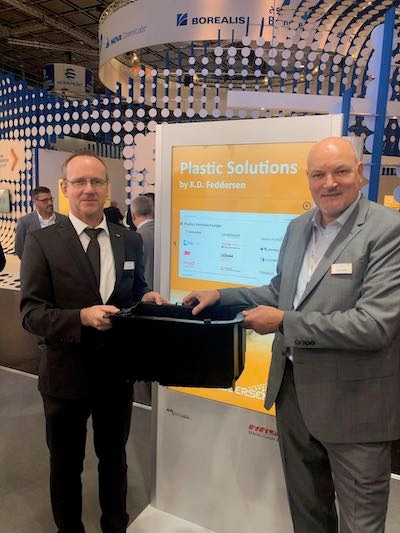European automaker VW appears committed to greater use of polypropylene in its future vehicles.
October 21, 2019

The weight-saving attributes of polypropylene, coupled with better noise properties, have placed it in pole position for expanded use in electric vehicles. Germany’s Volkswagen (VW) is one such OEM sanguine about the prospects of the resin moving forward.
|
Feddersen’s Gerd Karn (left) and colleague and Account Manager Thomas Neven with the battery box housing of the VW Pluto. |
VW’s ID3 electric vehicle (EV), for example, switched from PC/ABS and ABS to PP on account of its lower density and less propensity to squeak compared with styrenic-based plastics. There is also an emerging preference for lower gloss finishes in vehicles that are achievable with PP. Increasingly. Larger parts such as door panels and center consoles, as well as door pillars, will employ PP in EVs according to Gerd Karn, Business Development Manager at plastics distributor and compounder K.D. Feddersen. Karn was speaking to PlasticsToday at the K Show in Düsseldorf.
Feddersen has been active in various auto-related projects of late that selected PP. VW ride-sharing provider MOIA launched the electrically-driven VW Pluto in Hamburg in early 2019. The battery box for the electrical system is manufactured by H & H Gesellschaft für Engineering und Prototypenbau mbH using Hostacom G3 R05 105555 from LyondellBasell, a PP with 30% glass fiber reinforcement that complies with the VW standard 44045 PP10. “With Hostacom G3 R05 105555 from LyondellBasell, we recommended a PP compound which is easy-flowing, has excellent mechanical properties and also presents very low warpage,” explains Gerling. According to the distributor, the material is also recyclable and offers a very good price-performance ratio.
According to VW standard 44045, the components on the surface and the interior must not have any imperfections or manufacturing defects such as flow lines, cavities or tears. Sink marks in the base area of ribs and reinforcements are only allowed if they do not impact the functionality and appearance of the component. Flawless installation must also be guaranteed. Under the PP10 notation, it is noted that the application area for highly thermally stressed parts has high requirements in terms of strength, stiffness and shape retention.
In another recent case of PP adoption, Hostacom TRC 364N from LyondellBasell was employed for the seat trims in the Daimler Sprinter van. Good processability and balanced mechanical properties, combined with the good scratch- and UV-resistance, as well as low emissions and odor, prompted processor Karl Etzel GmbH to use this material in the Daimler Sprinter.
For some years, it has been using Hostacom TRC 364N for seat trims in Daimler passenger cars in the Daimler color shade black 9051. Due to the long-standing successful cooperation with Feddersen and LyondellBasell, as well as the successful use of the material in the passenger car segment, the decision to use the 18 % talcum-reinforced PP-compound was easy and the component approval was granted quickly.
About the Author(s)
You May Also Like





